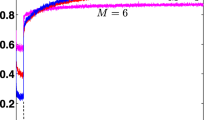Abstract
In most wireless communication systems, the additive noise is assumed to be Gaussian. However, there are many practical applications where non-Gaussian noise impairs the received signal. Examples include co-channel and adjacent channel interference in mobile cellular systems, impulsive noise in wireless and power-line communications, ultra-wide-band interference and multi-user interference in wireless systems, and spectrum sensing. To cover this issue, we consider in this paper the application of the sum of generalized Gaussian (GG) random variables (RVs). To this end, we consider single-input multiple-output (SIMO) systems that operate over Nakagami-m fading channels in the presence of an additive white generalized Gaussian noise (AWGGN). Specifically, we derive a closed-form expression for the bit error rate (BER) of several coherent digital modulation schemes using maximal ratio combining diversity in the Nakagami-m fading channels subject to an AWGGN. The derived expression is obtained based on the fact that the sum of L GG RVs can be approximated by a single GG RV with a suitable shaping parameter. In addition, the obtained BER expression is valid for integer and non-integer value of the fading parameter m. Analytical results are supported by Monte-Carlo simulations to validate the analysis.







Similar content being viewed by others
Notes
Some authors use “excess kurtosis”. As such, \(-\hbox {3}\) must be added to (6). However, using “excess kurtosis” or “kurtosis” will not affect neither the derivations nor the results.
References
Simon, M. K., & Alouini, M.-S. (2005). Digital communications over fading channels. New York: Wiley.
Zhu, B., Yang, F., Cheng, J., & Wu, L. (2016). Performance bounds for MRC and SC over Nakagami-\(m\) fading channels with arbitrary correlation. In Proceedings of ICNC, (pp. 1–6).
Aruna, G. (2014). Performance analysis of MRC receiver with channel estimation error and co-channel interference in Nakagami-\(m\) fading channel. In Proceedings of IEEE ICCIC, (pp. 1–4).
Mekloi, N. (2014). Outage probability of MRC diversity for arbitrary parameters in Nakagami fading. In Proceedings of iEECON, (pp. 1–4).
Yu, H., Wei, G., Ji, F., & Zhang, X. (2011). On the error probability of cross-QAM with MRC reception over generalized \(\eta \)–\(\mu \) fading channels. IEEE Transactions on Vehicular Technology, 60(6), 2631–2643.
Tahir, Y. H., Al-Hussaibi, W., Ng, C. K., Noordin, N. K., & Mohd Ali, B. (2014). High reliability of real-time visual data transmission using superposition coding with receiver diversity. Telecommunication Systems, 57(2), 107–118.
Singh, A. D., & Subadar, R. (2016). Performance of dual-EGC receivers over TWDP fading channels. Telecommunication Systems, 63(3), 473–479.
Hasan, M. I., & Kumar, S. (2017). Spectral efficiency of dual diversity selection combining schemes under correlated Nakagami-\(0.5\) fading with unequal average received snr. Telecommunication Systems, 64(1), 3–16.
Badarneh, O. S., & Almehmadi, F. S. (2016). Performance of multihop wireless networks in \(\alpha \)-\(\mu \) fading channels perturbed by an additive generalized Gaussian noise. IEEE Communication Letters, 20(5), 986–989.
Badarneh, O. S. (2015). Error rate analysis of \(M\)-ary phase shift keying in \(\alpha \)–\(\eta \)–\(\mu \) fading channels subject to additive Laplacian noise. IEEE Communications Letters, 19(7), 1253–1256.
Badarneh, O. S., Aldalgamouni, T., & Almehmadi, F. S. (2017). A unified framework for performance evaluation over generalized fading channels. Telecommunication Systems, 64(4), 669–678.
Kishk, M.A., & Alaa, A. M. (2014). On the capacity of the underwater acoustic channel with dominant noise sources. In IEEE 2nd International Symposium on Telecommunication Technologies (ISTT), (pp. 183–187).
Yang, X., Li, M., & Zhao, X. (2011). Optimum detectors of line spectrum signals in generalized Gaussian noise. Third International Conference on Measuring Technology and Mechatronics Automation, vol 2, (pp. 819–822).
Salahat, E. (2014). Unified performance analysis of maximal ratio combining in \(\eta \)–\(\mu \), \(\lambda \)–\(\mu \) and \(\kappa \)–\(\mu \) generalized fading channels. In Proceedings of 80th IEEE VTC-Fall, (pp. 1–5).
Zhao, Q., Li, H.-W., & Shen, Y.-T. (2004). On the sum of generalized Gaussian random signals. In Proceedings of 7th ICSP, (pp. 50–53).
Soury, H., & Alouini, M.S. (2015). New results on the sum of two generalized Gaussian random variables. In GlobalSIP, (pp. 1017–1021).
Gradshteyn, I. S., & Ryzhik, I. M. (2007). Table of integrals, series, and products (7th ed.). Millbrae, CA: Academic Press.
Prudnikov, A . P., Brychkov, Y . A., & Marichev, O . I. (1990). Integrals, and series: more special functions (Vol. 3). New York: Gordon & Breach Science Publishers.
Erdélyi, A. (1955). Higher transcendental functions (3rd ed.). Maidenhead: McGraw-Hill.
Proakis, J . G. (1989). Digital Communications (2nd ed.). Maidenhead: McGraw-Hill.
Kilbas, A., & Saigo, M. (2004). H-transforms : Theory and applications (analytical method and special function) (1st ed.). Boca Raton: CRC Press.
Author information
Authors and Affiliations
Corresponding author
Rights and permissions
About this article
Cite this article
Badarneh, O.S., Almehmadi, F.S. & Aldalgamouni, T. On the application of the sum of generalized Gaussian random variables: maximal ratio combining. Telecommun Syst 67, 415–422 (2018). https://doi.org/10.1007/s11235-017-0346-8
Published:
Issue Date:
DOI: https://doi.org/10.1007/s11235-017-0346-8




